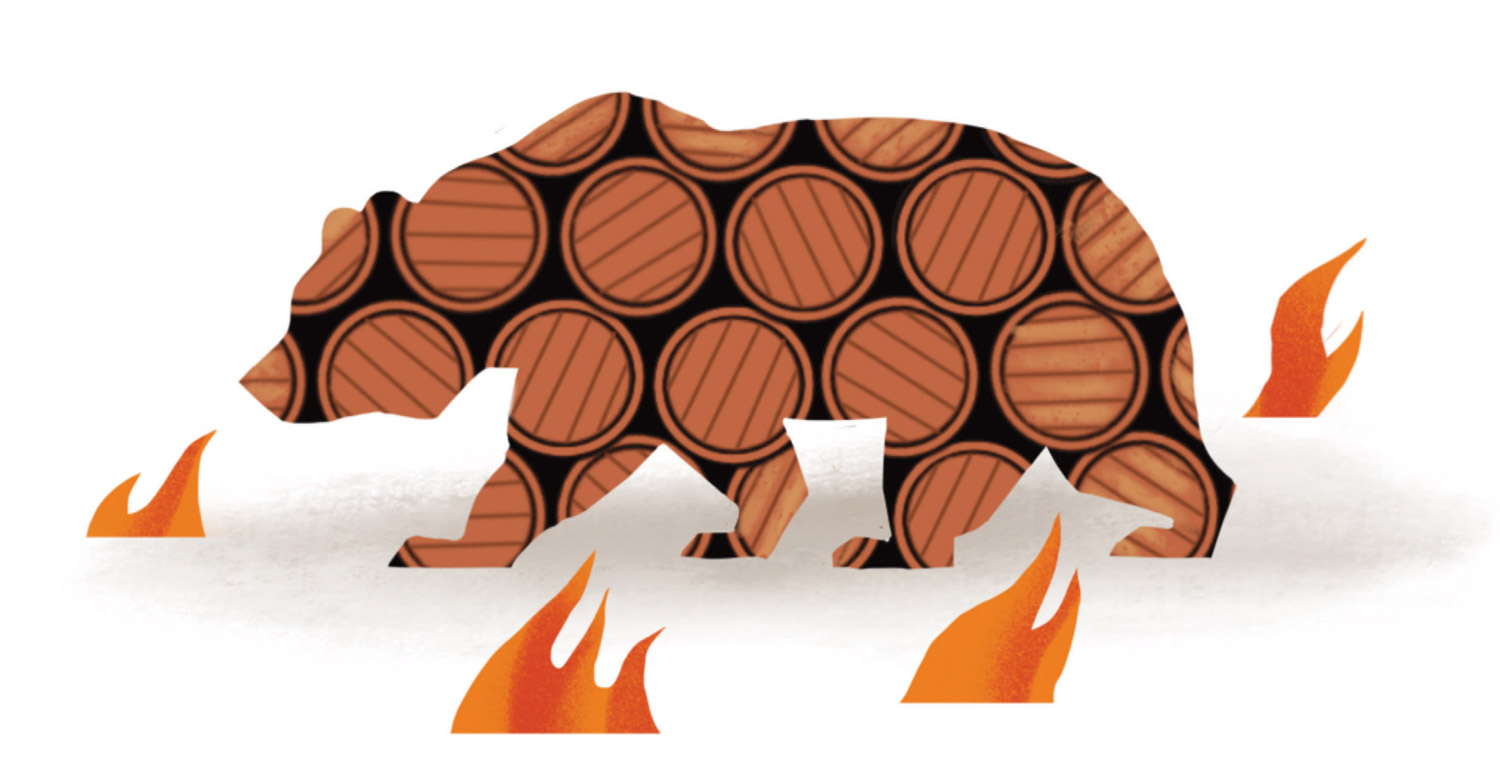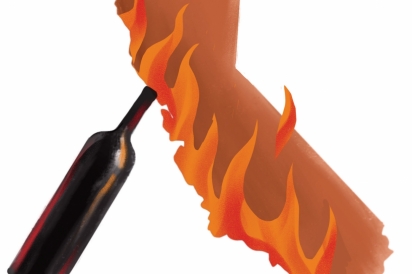The Last Fire Season?
For more than half a decade, increasingly hot and destructive fires have threatened the very existence of Wine Country in California. In the aftermath of the most destructive season of fires ever, stakeholders are making an effort—perhaps the last—to finally put a stop to the annual season of flames.
It would be difficult to overstate the value of the wine industry to the state of California and, by extension, to the nation as a whole. Devoid of hyperbole, the statistics are staggering: The California wine industry is responsible for $114 billion (with a “b”) dollars of the American economy annually. It employs 786,000 people across the United States, pays $35 billion in wages, donates $249 million to charity and attracts 23.6 million tourists every year. In California alone, 4,200 bonded wineries account for over $1 billion in export revenue and pay out $15.2 billion in state and federal taxes annually. And while all 50 states produce wine, only one accounts for three of every five bottles sold: California. These numbers, only the very tip of the proverbial iceberg, are more than equal to making the case that the California wine industry is a critical cog in America’s economic machine.
There’s only one problem: The industry is burning to the ground.
If the iceberg is proverbial, the fires are anything but. According to a joint study from universities on three continents, in 2018, 8,500 unique fires ravaged California, costing the state over $100 billion in losses. That’s approximately one half of 1% of America’s annual GDP. Despite financial losses, loss of land and, most horribly, loss of life, the California wines produced in 2018, though young, are drinking very nicely today.
That’s not the case for 2020, when 8,200 unique fires, including the infamously destructive Glass Fire, burnt over four million acres—twice as many as any previous year—and caused smoke taint so significant that many producers refused even to produce a 2020 vintage—especially the reds, which tend to ripen later than white grapes do.
Speaking with NBC News that year, with blazes still raging across Wine Country, Cal Fire director Thom Porter stated the needs bluntly: “It’s not just more firefighters. It’s not just more aircraft. It’s not just fuel reduction project work. It’s not just defensible space or home hardening. It’s absolutely every one of those things.”
The Napa County Board of Supervisors may have been listening as Porter spoke, or perhaps they already realized that the future of their world-famous wine-producing valley, only 30 miles long by three miles wide, depended upon decisive and efficacious action to prevent future fires. In April 2021, the board voted unanimously to contribute $42.5 million over five years to improve infrastructure and combat the epidemic of fires. This money is largely intended to address the multitude of issues that Porter spoke of.
Of that $42.5 million, $5.4 million was authorized to be spent in the first year. That, coupled with an expected eight-figure payout in damages from Pacific Gas & Electric, the utility whose negligence is allegedly responsible for starting some of the fires, should cover much of the immediately required expense, but the 10-year plan is not yet fully funded. In exploring other sources of revenue, the Napa Valley Register reported that the Board is apparently divided on a proposed ballot measure that would increase sales tax by a quarter cent. Quoted in the Register, Napa County Fire Chief Geoff Belyea anticipated that this increase would raise some $10 million annually.
Since 2017, fires have destroyed more than 1,500 urban structures in Napa alone, including houses, wineries, other businesses and more. In that same period, 45,726 structures have burned in the state of California. Some of the most destructive fires, including in Wine Country, have been caused by malfunctions in outdated electrical infrastructure such as power lines and fences. Some of the money will be used to update that infrastructure, improving electrical equipment and facilities, helping to prevent fires before they even begin. The money will also be put toward much-needed land management.
Part of the reason that Wine Country has burnt so consistently in recent years is that it is, in fact, very flammable. California has over 33 million acres of forested land, and well over half of that is owned by the federal government. The state owns approximately 3% of the land. The rest is privately held or owned by Native American tribes. That which is held privately—including most of Napa Valley—is the responsibility of landowners, but a general emphasis on fire suppression rather than fire prevention has done little to promote the devotion of resources necessary to truly prevent fire outbreaks.
In April, the Napa Communities Firewise Foundation and the Napa County Fire Department unveiled a five-year plan aimed specifically at fuel reduction. It calls for the creation of fuel breaks, the clearing of roadside vegetation and other measures. As a part of this, crews have already constructed a two-and-a-half-mile-long fuel break around Circle Oaks, a hamlet just east of the city of Napa.
But firebreaks alone are unlikely to solve the problem. Many vineyard practices—including some very trendy approaches to viticulture—contribute greatly to the problem. Jean Hoefliger is a consultant who works with wineries up and down the left coast, including many in the counties of Napa and Sonoma. Asked about fire, Hoefliger was quick to point out what producers, including many that he works with, can do to help prevent fires.
“Vineyards are, 97% of the time, amazing fire breaks,” he said. “The exceptions are organic and hillside.” The problem with organic—and even more so biodynamic— vineyards is an approach that allows all kinds of flora, planted intentionally or else left alone, to thrive between the vines. Hillside vineyards rely largely on the roots of grass, shrubs and other plants to prevent erosion. And all of these plants, of course, can burn.
Newton, one of the wineries where Hoefliger works as a consultant, lost everything in the Glass Fire of 2020. Of their 70 acres, 67 burned—as well as the winery and other structures. Most of those vineyards were organic and planted on a hillside. Other wineries that Hoefliger consults for, in various locations throughout Wine Country, are taking their own precautions.
“At Pope Valley Winery, we have created fire roads to ensure that the firefighters have better, faster access to the property in case of a fire,” said Hoefliger of the eponymous Pope Valley AVA winery. At Maxville Winery, located in the Chiles Valley AVA, they cleared the mouth of the cave of all flammable objects. “Caves don’t burn,” quipped Hoefliger, “but smoke finds its way into them easily enough.”
Newton is rebuilding, taking care to include Cal Fire in the planning. Their vineyards, known for producing extraordinary Bordeaux varietals, will be replanted as organic vineyards, and most will remain on the hillsides, as well. However, they’re moving all pipes underground, adding more firebreaks and implementing a completely new forest management structure. Hoefliger wants to ensure that the wineries he’s involved with are as prepared as they can possibly be to prevent, and if necessary suppress, fires in the future. “That means building firebreaks, more roads. It means not planting certain plants. It means rethinking landscaping, rethinking everything,” he said.
Fire prevention is central to the continued existence of Wine Country, and the onus of preventing fires falls not only to government entities and officials, but also to private landowners and to individuals who inhabit or visit Wine Country. Emphasis on preventative measures, rather than merely on the suppression of fires once they have started, marks something of a shift in approach, and that the Napa County Board of Supervisors has specifically earmarked money for prevention is noteworthy. Whether money is spent on fuel breaks and clearing debris or instead upon firefighting trucks, helicopters and more full-time firefighters makes a statement about the approach, but those most closely involved and most significantly affected are quick to point out that this isn’t a dichotomy. Regardless of the approach—prevention or suppression— this is only one aspect of the issue. For those in the industry, another is insurance.
Between 1960 and 1980, California averaged $100 million in fire claims against insurance annually. Between 2000 and 2010, the figure rose to six times that amount. Those figures, however, pale in comparison to recent years. In 2019, the amount rose to $4 billion, and in 2020, it more than doubled to $9 billion. It was already well-understood by those in the wine industry that the payouts from insurance on vineyards and structures damaged by fire were never sufficient to make the owners whole again, but a July article in the San Francisco Chronicle more widely illuminated the dire circumstances facing the wine industry. As the number of claims has skyrocketed, insurance premiums have risen to nearly cost-prohibitive levels, leaving many winemakers weighing their odds. Other wineries have been entirely dropped by their insurers, their level of risk apparently too high for actuaries to green-light— regardless of the premium.
Of course, there is also the 20,000-foot view, the big picture regarding climate change. The world, including California, is markedly hotter and drier than it used to be and, thus, more susceptible to the flames. “We’re seeing a bigger risk earlier,” noted Hoefliger. “We had the moisture at the end of May that we’d expect at the end of August—and these conditions facilitate an earlier and longer fire season.” To invest in helicopters, firebreaks, the replanting of burned vineyards and the rebuilding of burned wineries without also seeking to fight the long-term effects of climate change would be to miss the forest for the trees, an especially grievous miscalculation when so many of those trees are, in fact, on fire.
Whether this impressive combination of effort and money is enough to finally stem the increasingly violent, devastating fires that have plagued Wine Country for all of recent memory is a matter still to be determined. Will the Napa County Board of Supervisors’ large financial contributions and commitment to not only suppression but prevention, coupled with the individual efforts of vineyard owners and managers, combined with the best efforts of the human race to combat the effects of climate change, be enough to ensure that the devastation of 2020 remains uniquely horrible, or will we instead in 2021 see, as we did in 2019 and again in 2020, damage and destruction the likes of which we had never seen before? Like it or not, we’ll find out soon enough.







